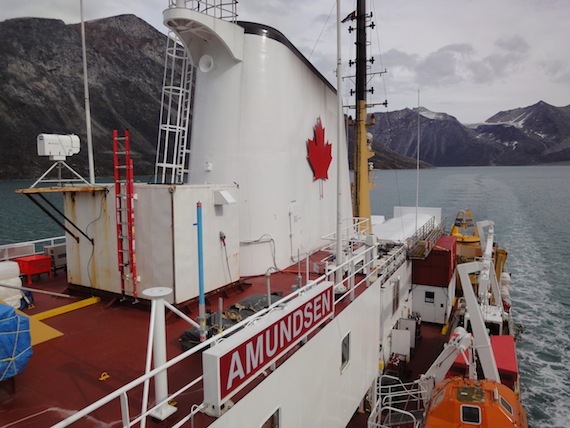Tories to consider arming Arctic-bound coast guard ships
“It makes total sense to have the capability for greater enforcement if it becomes necessary”

Someday the Canadian Coast Guard’s icebreakers— like the Amundsen— may be armed as a way to bolster Arctic sovereignty. (PHOTO BY JANE GEORGE)
Randy Boswell
POSTMEDIA NEWS
The Conservative government has revealed that it will consider arming the Canadian Coast Guard’s icebreakers as a way to bolster Arctic sovereignty.
The commitment to study the option of placing guns on coast guard ships was the highlight of the government’s tabled response this week to recommendations in a report from the Senate fisheries committee about strengthening Canada’s presence in the North.
The government has also indicated that it will review new shipping regulations in the Northwest Passage and other Arctic waters with an eye to extending mandatory registration of foreign vessels — which currently applies only to large freighters and other heavy ships — to all foreign-ship traffic in the region, regardless of size.
The responses, delivered by Fisheries and Oceans Minister Gail Shea on behalf of the government, were well received by Senator Bill Rompkey, the Liberal chair of the committee that issued the December report titled “Controlling Canada’s Arctic Waters: Role of the Canadian Coast Guard.”
“My reaction is very positive,” Rompkey told Postmedia News on Thursday, adding that he was “very gratified” by the government’s commitment to at least examine the proposals to put deck guns on icebreakers and to make registration mandatory for all foreign ships travelling in the Canadian Arctic — where melting ice has recently been opening up historically impassable sea routes.
“We need to know what vessels of all kinds are doing up there,” said Rompkey, citing terrorism, drug-smuggling and illegal immigration as potential sources of trouble in a less-frozen Far North. “And we know there are going to be more ships going through there.”
The Senate committee had urged the government to equip icebreakers “with deck weaponry capable of giving firm notice, if necessary, to unauthorized foreign vessels” in Canada’s northern waters.
The government responded that it “partially supports” the recommendation and that it will “review the Canadian Coast Guard enforcement role, including the possibility of arming CCG icebreakers.”
Two of Canada’s leading experts on Arctic geopolitics also applauded the government for agreeing to study the idea of arming the country’s icebreakers.
“It makes total sense to have the capability for greater enforcement if it becomes necessary,” said University of Calgary political scientist Rob Huebert.
And Michael Byers, a University of British Columbia expert on international law, said the “quiet authority of a deck-mounted gun” is a reasonable show of force in the Arctic, and does not constitute a provocation to foreign countries or “preparing for war with the Russians.”
All coast guard icebreakers, he said, should be “multi-purpose vessels” that not only perform navigational assistance, conduct scientific research and provide search-and-rescue services, but also bring both the symbolic and practical might of a “light machine gun” to the job of enforcing Canada’s sovereignty in the Arctic.
He added that sending two ships worth millions of dollars to deal with an Arctic security breach — an unarmed coast guard icebreaker, for example, and an armed Canadian Forces vessel — defies logic given the vastness of the Canadian Arctic and the evident efficiency of sending a single, armed vessel with a full range of capabilities.
Byers and Huebert also urged the government to adopt the Senate recommendation to extend Arctic ship-reporting requirements to smaller vessels.
The current 300-tonne threshold for mandatory registration of foreign ships — announced by Shea earlier this year and implemented on July 1 — is chiefly aimed at preventing a major oil or chemical spill in Canada’s Arctic.
But Byers, who served as a consultant on the Senate committee’s report, said federal ship-tracking regulations “should not only be about protecting the Arctic environment. They should also be about protecting Canadian sovereignty, and you can violate that with a ship less than 300 tonnes.”
Huebert said the government’s apparent new openness to strengthening the enforcement capacity of the Canadian Coast Guard could represent a historic shift in the agency’s role in maintaining law and order on Canadian waterways.
“What all of this points to is a reconsideration of what the Canadian Coast Guard is,” he said, suggesting Canada may be ready to remodel the agency more along the lines of the quasi-military U.S. Coast Guard.
Already armed with guns and mandated to combat smuggling and perform a wide range of homeland-security functions in American waters, U.S. Coast Guard ships carry out many roles in that country that would require RCMP or Canadian Forces involvement in Canada, he said.
Huebert foresees a more modest “modification” of the Canadian Coast Guard’s traditional mandate, but one that would be appropriate for “a changing, modern time” in which new security threats are certain to arise in increasingly accessible Arctic waters.





(0) Comments